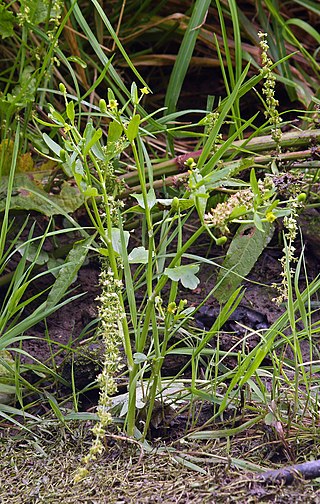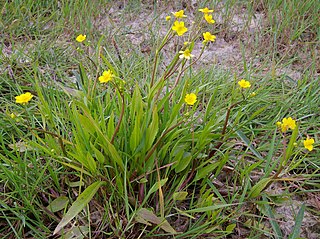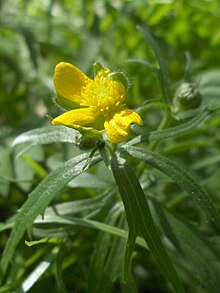
Ficaria verna, commonly known as lesser celandine or pilewort, is a low-growing, hairless perennial flowering plant in the buttercup family Ranunculaceae. It has fleshy dark green, heart-shaped leaves and distinctive flowers with bright yellow, glossy petals. Native to Europe and Western Asia, it is now introduced in North America, where it is known by the common name fig buttercup and considered an invasive species. The plant is poisonous if ingested raw and potentially fatal to grazing animals and livestock such as horses, cattle, and sheep. For these reasons, several US states have banned the plant or listed it as a noxious weed. It prefers bare, damp ground and is considered by horticulturalists in the United Kingdom as a persistent garden weed; nevertheless, many specialist plantsmen, nursery owners and discerning gardeners in the UK and Europe collect selected cultivars of the plant, including bronze-leaved and double-flowered ones. Emerging in late winter with flowers appearing late February through May in the UK, its appearance across the landscape is regarded by many as a harbinger of spring.

Ranunculus is a large genus of about 1700 to more than 1800 species of flowering plants in the family Ranunculaceae. Members of the genus are known as buttercups, spearworts and water crowfoots.

Ranunculus repens, the creeping buttercup, is a flowering plant in the buttercup family Ranunculaceae, native to Europe, Asia and northwestern Africa. It is also called creeping crowfoot and sitfast.

Ranunculus glacialis, the glacier buttercup or glacier crowfoot, is a plant of the family Ranunculaceae. It is a 5-10(-20) cm high perennial herb. Often with a single relatively large flower, with 5 petals first white later pink or reddish. The underside of the 5 sepals are densely brown-hairy. The leaves are fleshy, shiny, and deeply loped, forming 3 leaflets. Ranunculus glacialis reported to have a diploid chromosome number of 2n = 16.

Ranunculus bulbosus, commonly known as bulbous buttercup or St. Anthony's turnip, is a perennial flowering plant in the buttercup family Ranunculaceae. It has bright yellow flowers, and deeply divided, three-lobed long-petioled basal leaves.

Ranunculus acris is a species of flowering plant in the family Ranunculaceae, and is one of the more common buttercups across Europe and temperate Eurasia. Common names include meadow buttercup, tall buttercup, common buttercup and giant buttercup.

Ranunculus glaberrimus, the sagebrush buttercup, is a species of flowering plant in the buttercup family, Ranunculaceae. It is native to interior western North America, in western Canada, the western United States, and the northwestern Great Plains.

Ranunculus sceleratus known by the common names celery-leaved buttercup, celery-leaf buttercup, and cursed buttercup is a species of flowering plant in the buttercup family Ranunculaceae. It has a circumpolar distribution in the northern hemisphere, native to temperate and boreal North America and Eurasia, where it grows in wet and moist habitats, including ponds and streambanks.

Ranunculus flammula, the lesser spearwort, greater creeping spearwort or banewort, is a species of perennial herbaceous plants in the genus Ranunculus (buttercup), growing in damp places throughout the Boreal Kingdom. It flowers June/July. Ranunculus flammula is poisonous. It is very closely related to R. reptans, which is distinguished by prostrate and more slender stems, narrower leaves and smaller flowers and is sometimes included within R. flammula sensu lato as a variety.

Ranunculus gmelinii, Gmelin's buttercup or small yellow water-crowfoot, is a species of flowering plant in the buttercup family, Ranunculaceae. It is native to northern North America, where it occurs across Canada and the northern and higher-elevation regions of the United States. It is also present in Eurasia.

Ranunculus alismifolius is a species of buttercup known by the common name plantainleaf buttercup. It is native to western North America from British Columbia to California to Colorado, where it grows in moist mountain habitat such as meadows, streambanks, and bogs, becoming common to abundant in some places. It is somewhat variable in appearance and there are several varieties which can be hard to tell apart. In general the plant is a perennial herb producing a few usually upright to erect, branching stems from a fleshy, fibrous root system. It can be up to half a meter tall, or it can remain quite short and clumpy. The leaves vary in shape, the lower ones with oval blades and the upper linear to lance-shaped, all borne on long petioles. The inflorescence bears one or more flowers, each on a long pedicel. The flower has up to 12 yellow petals and many yellow stamens and pistils at the center. The fruit is an achene, borne in a spherical cluster of 12 or more.

Ranunculus andersonii is a species of buttercup known by the common name Anderson's buttercup. It is native to the western United States, including the Great Basin and surrounding regions, where it grows in sagebrush, woodlands, and other habitat. It is a perennial herb producing a basal rosette of thick leaves which are each divided into three double-lobed leaflets at the end of a petiole. The inflorescence arises from the rosette on an erect, leafless stalk usually no more than 20 centimeters tall. It bears one flower with usually five white or red-tinged petals each up to 2 centimeters long with white or pinkish sepals at the base. At the center of the flower are many yellow stamens and pistils. The fruit is an achene, borne in a spherical cluster of 14 or more. It was named after Charles Lewis Anderson by Asa Gray.

Ranunculus eschscholtzii is a species of buttercup flower known by the common name Eschscholtz's buttercup.

Ranunculus flabellaris is a species of flowering plant in the buttercup genus, Ranunculus, known by the common name yellow water buttercup. It is native to much of North America, including the southern half of Canada and most of the United States.

Ranunculus parviflorus is a species of buttercup known by the common name smallflower buttercup. It is native to Europe, but it is known on other areas of the world as an introduced species and sometimes a roadside weed, for example, in parts of Australia and the United States.

Ranunculus pusillus, commonly called low spearwort, is a species of flowering plant in the buttercup family (Ranunculaceae). It is native to much of the eastern United States from New York to Florida and west to Texas; it is also known in California. It grows in wet habitat, where it is semi-aquatic growing partially submerged or terrestrially on muddy substrates.

Ranunculus pedatifidus is a species of buttercup known by the common names surefoot buttercup, northern buttercup, and birdfoot buttercup. It has a circumpolar distribution, occurring throughout the northern latitudes of the Northern Hemisphere. There are two varieties, var. pedatifidus occurring mostly in Asia and var. affinis mostly native to North America.
Ranunculus allenii, commonly known as Allen's buttercup, is a flowering plant in the crowfoot or buttercup family, Ranunculaceae. Generally found in wetlands in northern latitudes, it bears yellow flowers in summer, which are pollinated by insects.

Ranunculus arcticus, the birdfoot buttercup, is a species of buttercup in the family Ranunculaceae. It has a circumpolar distribution in Northern Europe, Northern Asia and North America.

Gunnar Marklund was a Finnish botanist.



















